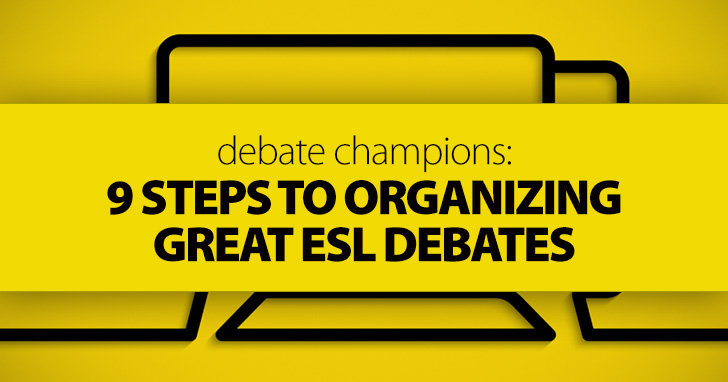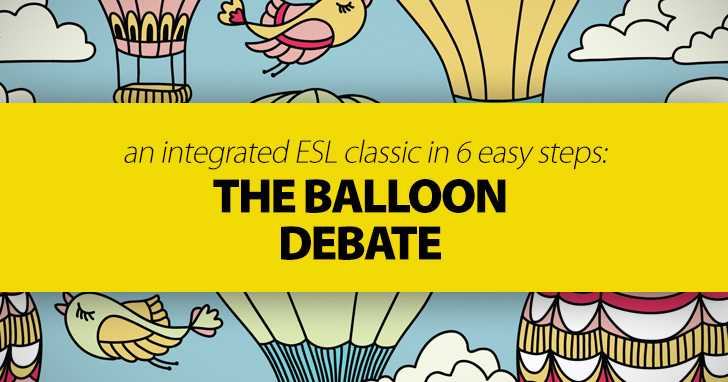Debate Champions: 9 Steps to Organizing Great ESL Debates


My favorite way to reward them is with a game such as The Bridge or by playing Jeopardy. Another option is a classic moral dilemma, adapted for the ESL classroom: The Balloon Debate.

I wrote a one-page introduction for my class to read together; you could do the same, or it could be a short listening exercise. The text might read:
The attention of the world’s media is focused today on five teams of celebrities who are competing in a round-the-world balloon race. They will begin in Boston and fly east over the Atlantic. The race intends to raise millions of dollars for worthy charities, and will feature ‘Big Brother’-type fixed-camera TV and Internet coverage, which expected to bring in hundreds of thousands of viewers.
At this point, check the important vocabulary (balloon, competition, celebrity, charity, coverage) and establish why the race is taking place. Elicit some examples of charities and how they help people. Ask about conditions on a hot air balloon, and perhaps about the physics of what keeps them in the air.
Then, introduce the passengers. There is a single pilot, as well as five celebrities. I would recommend against using real celebrities, as pre-existing opinions will unhelpfully color the debate. Feel free to be inventive with the details, but I recommend a mix of ages, genders, skills, titles and special details. Here are three examples:
Dr. Stephen Fairfax (aged 76) is a pioneering surgeon and inventor of the artificial heart valve. He still teaches at a prestigious university and has mentored several of the world’s leading surgeons.
Angelica Lombardi (aged 34) is an Oscar-winning Italian actress and supermodel. She has used her considerable fame to raise money for charities, and was recently referred to in the British press as ‘The Italian Diana’. She has adopted two children with her partner.
Professor Jim Myers (aged 51) is a ‘once in a generation mind’, according to Stephen Hawking. His work on cosmology and quantum physics has revolutionized our understanding of the universe. He writes prolifically and appears on cable TV regularly to debunk bad science and encourage young people to enter the profession. He has three grown children.
The students should, from the outset, form a picture of these individuals and begin to establish their views on each person’s value to society. Perhaps elicit opinions on which of the five professions is the most worthwhile; include sports and the arts, though they will generally be pushed lower down the list by business people, scientists and medics. What do these opinions tell us? Are there any strong views either way?
Describe the situation to your students, either as a reading or listening task.
The balloon sets off successfully from Boston and makes its way slowly across the Atlantic. After a few hours of good progress, the pilot suddenly begins to look worried. The balloon’s supply of fuel seems to be leaking and, when the pilot investigates the tank, discovers that it cannot be stopped. He calculates that they will be unable to make landfall, and cannot turn back because of unfavorable winds. The only way any of them can survive is if the balloon sheds as much weight as possible. The passengers throw out everything they can find, but the difference is minimal. The pilot makes it clear to a panicking group that the true problem is the weight of the people…
Invite the students to consider the order in which the five passengers should be thrown out of the balloon. What criteria will they use? Should the oldest person go first, irrespective of his health and status? Or perhaps the youngest? Should it be the person seen as least valuable to society, even if they have children?
Inform your students that the pilot cannot be thrown out, as no-one else can safely land the balloon, and that (for the purposes of the exercise) all five passengers have the same weight. Scientists can neither repair nor pilot the balloon, and no rescue is available, as it is night time and a panicked passenger has already thrown the GSP transponder overboard.
Compare the students’ lists. Do any themes emerge? Why?
Each student will now represent one of the characters. They can be assigned randomly, or through a system of your choosing; larger classes will end up with two or three of each character, which is fine.
To prepare for the debate, the students should consider two aspects:
Give them a few minutes to make some notes, guarding against writing full sentences which they will simply read during the debate; the aim is fluent and spontaneous language production. If necessary, review the language of agreement and disagreement, comparison (I’m more vital to the economy than you are…), persuasion and criticism.
The students have ten minutes (approx.) to persuade each other of their importance. Their objective is to push their way to the bottom of the list, so that they’re less likely to be thrown out. Monitor this (usually very noisy and boisterous) activity, throwing in ideas to complicate or simplify the debate, as necessary. Each student should spend time with an example of every other character, so they will have at least four conversations.
Once the dust has settled, invite the students to compose their individual list, at the top of which is the person will be thrown out first. Tally these votes on the board, giving one point for the person in most peril, and five for the safest person. The character with the least points is then thrown out, followed by the second, etc.
Ask your students how this list came to be. What criteria did they use? Are they surprised by the results? What do they tell us about society, and how we view particular professions? What would have made the choice more difficult? Make notes on this last question, and consider adapting the debate to make it more difficult to choose between the five characters; I’ve spent years fine-tuning my own, and it’s different every time.
I hope it helps to create some memorably noisy and contentious classes!